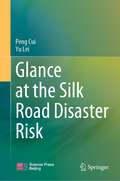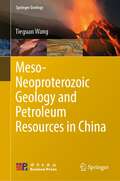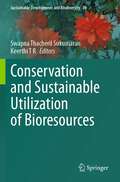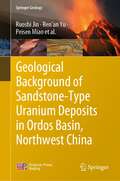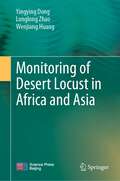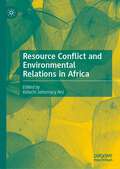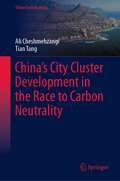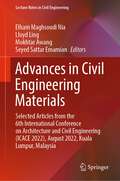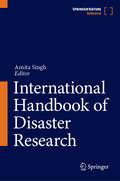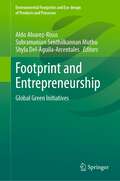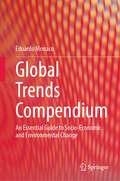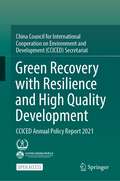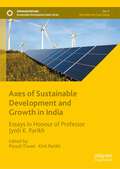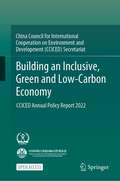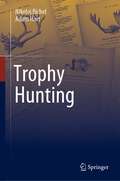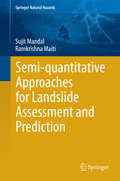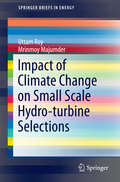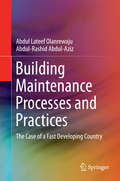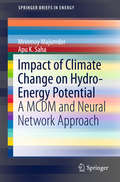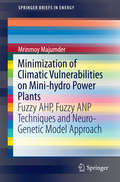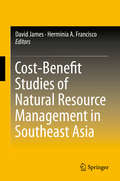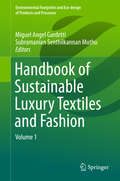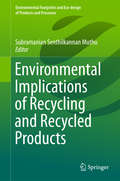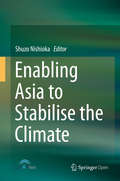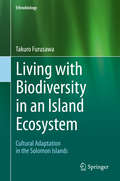- Table View
- List View
Glance at the Silk Road Disaster Risk
by Peng Cui Yu LeiThis book vividly shows the fostering environment, activity characteristics, distribution pattern, economic losses, casualties, disaster risks and management of earthquakes, mass movement, drought, floods, and marine disasters in the Silk Road region. It develops a multi-scale and multi-disaster risk assessment method to better assess and understand the Silk Road disaster risk. A multi-level collaborative risk management model has been proposed for transboundary disasters, and it also shares case studies on major disaster risk management. The book makes a major step forward to increase the understanding of the disaster risk of the Silk Road region. It presents a holistic understanding of the natural hazards and their induced disaster risks and is a valuable read for scholars, stakeholders and practitioners in the DRR community.
Meso-Neoproterozoic Geology and Petroleum Resources in China (Springer Geology)
by Tieguan WangThis book focuses on Meso- to Neoproterozoic geology and Petroleum resources in China. It offers the oldest sediments knowledge for petroleum generation, accumulation, alteration and preservation in the world. It provides a valuable contribution to the understanding of a potential Precambrian oil and gas exploration realm through well-developed Meso- to Neoproterozoic sedimentary strata with petroleum resources. This work will appeal to a wide readership, from geologists, geochemists, petroleum prospector, university faculty members to advanced students working for Precambrian and petroleum geological and geochemical research.
Conservation and Sustainable Utilization of Bioresources (Sustainable Development and Biodiversity)
by Swapna Thacheril Sukumaran Keerthi T RThis book brings together chapters related to sustainable utilization of biological resources, including in situ and ex situ conservation of rare, endangered, and threatened plants. The title also gives a special emphasis on marine sponges and mangrove ecosystems, which are two important untapped potential resources of the marine ecosystem and play a key role in maintaining the marine ecosystem. There is an urgent need for the conservation, exploration and utilization of bioresources for the growth and survival of human beings. Due to the significant reduction in biological resources, many countries are developing strategic action plans for the conservation and sustainable use of biological resources. That is where this book fills the gap by discussing the significant development of new products and methodologies for sustainable utilization of these resources. This book also unveils a world of novel bioactive molecules from medicinal plants and the marine ecosystem and explains how drug design pipelines can advance modern drug development. The target audiences for this book include biodiversity researchers who are working on technology and bioresource management issues and faculty and students in the environment research areas and Biodiversity conservation.
Geological Background of Sandstone-Type Uranium Deposits in Ordos Basin, Northwest China (Springer Geology)
by Ruoshi Jin Ren’an Yu Peisen MiaoThis book introduces the geological background of sandstone-type uranium deposits in the Ordos Basin, Northwest China. Through comparative study of a large number of practical data such as uranium, coal and oil boreholes, the research system takes sedimentary basin as a unit and fully utilizes geologicalprinciples and test analysis to study the basic geological, geophysical, geochemical and remote sensing image characteristics of the basin, and to restores the favorable uranium-forming geological background brought by the change of the cognitive sedimentary environment conditions. It can be used as a reference for researchers, practitioners and as well as teachers and graduate students working in uranium deposit geology, sedimentary geology and related areas
Monitoring of Desert Locust in Africa and Asia
by Yingying Dong Longlong Zhao Wenjiang HuangThis book deals with the topic on remote sensing monitoring of desert locust in Africa and Asia. Remote sensing monitoring of the occurrence and damage of desert locust is conducted by integrating cutting-edge technologies and methods in cross-disciplinary fields in remote sensing science, geographic information science, agronomy, plant protection, agricultural meteorology, mathematics, and computer science. The main contents include spatio-temporal data analysis and processing, desert locust breeding areas monitoring, pest migration path analysis and damage monitoring. Moreover, a desert locust remote sensing monitoring system is constructed and applied in the region of Africa and Asia countries. This book not only provides technical reference for remote sensing monitoring and application of desert locust but also serves as a research reference for scholars and graduate students engaged in agricultural remote sensing, agricultural information technology, plant protection and other related field. It will help to improve remote sensing monitoring and application of desert locust.
Resource Conflict and Environmental Relations in Africa
by Kelechi Johnmary AniThe book discusses the failure of many African governments in providing the social needs of the masses, thereby placing the citizenry on the desperate quest for economic resources. Unfortunately, in many African States, mineral resources are owned, explored and marketed by the machinery of the state. The problem arises when the masses begin to challenge state access and ownership of resources that are domiciled within their ancestral land, communities, and constituencies. Often the challenge and resistance to state ownership of resources is generated by communal or group sense of exploitation, negligence and widespread poverty in the face of high resource endowment and waste by the government officials. Paradoxically, in Niger Delta of Nigeria, as discussed in the book, the state has unleashed unlimited might upon all social groups and agitators, thereby leading to the increased act of taking arms by such groups. When the informal resource agitators succeed in arming themselves, they begin to demand social and environmental justice, thereby leading to mass armed conflict between them and the government security agencies. Sometimes, the confrontation could be between them and other rival local resource actors in the informal sector of their country’s economy bearing in mind that the resources within their jurisdiction have become the central determinant of national commonwealth. It is at that state of desperado to control access, extraction and sale of natural resources in a State, by different armed groups that the process of natural resources extraction qualifies as the most visible cause of conflicts and crises around the African continent that is the centrepiece of the book. This is quite understandable given that mineral resource is a gift of nature; and nature is that phenomenon that every human, group and nation claim to represent, or, believe to represent them.
China’s City Cluster Development in the Race to Carbon Neutrality (Urban Sustainability)
by Ali Cheshmehzangi Tian TangThe scope of this book is to map China’s city clusters and their individual directions for the national-level strategies in line with the 2060 carbon neutrality plan. Since China announced the carbon neutrality plan in autumn 2020, no study has looked at the role of city clusters in achieving this long-term plan. Hence, this study is believed to be the first attempt to explore this important topic from the city cluster perspective. It explores the challenges, opportunities, and directions of all 19 city clusters, allowing readers to have a clear picture of China’s historical and ongoing progress, as well as the challenges and opportunities that lie ahead. In a short time, China’s city clusters have helped boost regional economic development, infrastructure development, trade and business, and better urban–rural integration. With enhanced coordination of connection and transport networks in and between the city clusters, we see a growing number of initiatives beyond just the initial economic strategies. The dual approach of top-down policies and infrastructure systems and bottom-up governance and investments has helped China consider urban–rural development strategies and regional sustainable development. These factors are essential to be explored from the city cluster perspective and in line with China’s sustainable development and carbon neutrality directions. Hence, the book covers these points holistically, ensuring that regional planning and development are favored in the face of uneven urbanization trends.We anticipate this book to be a valuable resource for local governments and authorities, urban planners and practitioners, developers, and urban researchers. While the focus is on China’s city clusters, we believe there are similar examples elsewhere. Hence, lessons learnt from this book could apply to other countries, regions, and subregions. Lastly, the book aims to put regional sustainable development at the heart of longer-term strategies and plans, such as the case of China’s carbon neutrality plan.
Advances in Civil Engineering Materials: Selected Articles from the 6th International Conference on Architecture and Civil Engineering (ICACE 2022), August 2022, Kuala Lumpur, Malaysia (Lecture Notes in Civil Engineering #310)
by Elham Maghsoudi Nia Lloyd Ling Mokhtar Awang Seyed Sattar EmamianThis book presents selected articles from the 6th International Conference on Architecture and Civil Engineering 2022 (ICACE 2022), held in Malaysia. Written by leading researchers and industry professionals, the papers highlight recent advances and addresses current issues in the fields of civil engineering and architecture.
International Handbook of Disaster Research
by Amita SinghThis handbook is a comprehensive source of information, analysis and directions in disaster studies. It goes beyond the oft-explored issues of management and science related to the topic and explores policies, governance, law and decision-making combined with the processes of implementation and enforcement, all the while integrating the latest science and technology updates related to the topic, such as artificial intelligence and early warning systems. It brings together studies which relate to sociology, politics and institutional economics, which work under the impact of resource availability, issues of leadership and international laws. Disasters are trans-boundary and disaster studies are trans-disciplinary. It is this aspect which would form the fulcrum of contributions and present a new, refreshing and innovative design for the handbook. The transformatory pedagogy which started with the Hyogo Framework for action 2005-2015 and The Sendai Framework for Disaster Risk Reduction 2015-2030 outlines seven clear targets and four priorities for action to prevent new and reduce existing disaster risks. The four priority areas around which the book would revolve are (i) Understanding disaster risk; (ii) Strengthening disaster risk governance to manage disaster risk; (iii) Investing in disaster reduction for resilience and; (iv) Enhancing disaster preparedness for effective response, and to "Build Back Better" in recovery, rehabilitation and reconstruction.
Footprint and Entrepreneurship: Cases On Circular Economy And Entrepreneurship (Environmental Footprints And Eco-design Of Products And Processes Series)
by Aldo Alvarez-Risco Subramanian Senthilkannan Muthu Shyla Del-Aguila-ArcentalesThis book highlights ten cases of entrepreneurship that – in the context of circular economy – have redefined the paradigm of luxury and the notion of exclusivity that it requires. It shows how, by using technology and a new consumption model, the ten companies have created novel business models for luxury, and more intelligent forms of use better-suited to modern times.
Global Trends Compendium: An Essential Guide to Socio-Economic and Environmental Change
by Edoardo MonacoThis Compendium was conceived as a “pocket compass”, a practical guide that may help readers to orientate themselves while they explore global affairs and attempt to make sense of the highly interconnected, multidimensional challenges of contemporary human development. The book is intended to be an accessible, concise, yet comprehensive reference for anyone who hopes to better understand today’s world and its dramatic complexity. The aim is to highlight a relevant selection of the demographic, socio-economic, geo-political, and environmental macro-dynamics that define our time, and to explore in a practical way the indicators that can be used to monitor their evolution over time. In general, this project stems from the need to apply “systemic thinking” to the study of the world and to develop a holistic perspective that can bridge the gap that for too long has existed across academic disciplines and their respective focuses. The macro-trends featured in the book shed light, in particular, on the change that has been occurring over time in the vast Global South – a portion of the globe that accounts for over 80% of the world’s total population. The book’s ultimate – although not exclusive – target audience is undoubtedly composed of undergraduate students of subjects such as political science, international affairs, international development, human geography and the like. In addition, the Compendium may benefit professionals in both public and private organisations as well as members of the general public seeking to acquire "global development literacy" in manners that are academically sound, but also accessible and concise.
Green Recovery with Resilience and High Quality Development: CCICED Annual Policy Report 2021
by CCICEDThis open access book is based on the research outputs of China Council for International Cooperation on Environment and Development (CCICED) in 2021. It covers major topics of Chinese and international attention regarding green development, such as climate, biodiversity, ocean, BRI, urbanization, sustainable production and consumption, technology, finance, value chain, and related topics. It also reviews the progress of China‘s environmental and development policies and the impacts from CCICED. This is a highly informative and carefully presented book, providing insight for policy makers in environmental issues.
Axes of Sustainable Development and Growth in India: Essays in Honour of Professor Jyoti K. Parikh (Sustainable Development Goals Series)
by Piyush Tiwari Kirit ParikhThis book is written by prominent academics and practitioners, exploring problems and opportunities of growth in different aspects of sustainable development. The overarching themes running throughout the book are energy access, policy, climate change, human development and resource allocation in the context of India. The book will benefit policymakers and researchers with its inclusion of new evidence and solutions to meet developmental challenges.
Building an Inclusive, Green and Low-Carbon Economy: CCICED Annual Policy Report 2022
by CCICEDThis open access book introduces the major environmental green development issues from six major themes carbon neutrality, nature-based solution, watershed management and climate adaptation, BRI green development, sustainable food supply chain, ecosystem-based integrated ocean management focusing on the progress of China’s environment and development policies from 2021 accomplishments. It is based on the research outputs of CCICED in the year of 2021, which marks China’s start point of implementation of its 14th Five-Year Plan when world economy also strived to recover from the pandemic.
Trophy Hunting
by Nikolaj Bichel Adam HartThis book gets to the heart of trophy hunting, unpacking and explaining its multiple facets and controversies, and exploring why it divides environmentalists, the hunting community, and the public. Bichel and Hart provide the first interdisciplinary and comprehensive approach to the study of trophy hunting, investigating the history of trophy hunting, and delving into the background, identity and motivation of trophy hunters. They also explore the role of social media and anthropomorphism in shaping trophy hunting discourse, as well as the viability of trophy hunting as a wildlife management tool, the ideals of fair chase and sportsmanship, and what hunting trophies are, both literally and in terms of their symbolic value to hunters and non-hunters. The analyses and discussions are underpinned by a consideration of the complex moral and practical conflicts between animal rights and conservation paradigms. This book appeals to scholars in environmental philosophy, conservation and environmental studies, as well as hunters, hunting opponents, wildlife management practitioners, and policymakers, and anyone with a broad interest in human–wildlife relations.
Semi-quantitative Approaches for Landslide Assessment and Prediction
by Sujit Mandal Ramkrishna MaitiIn the present authors attempted to have a clear insight into the interworking of geotectonic, geomorphic, hydrologic and anthropogenic factors leading to landslide in the Shiv khola Watershed, the most worst affected region of Darjiling Himalaya. This book includes the parameters responsible for landslide events in mountainous areas. It provides knowledge and understanding to the local people, planners, and policy makers about the causes and consequences of landslides as well as provides a suitable method to mitigate the landslips. The book deals with the role of land, water and soil in landslide phenomena. These three attributes have been described in terms of critical rainfall, critical slope, critical height and changes and development of drainage network in landslides. Mitigations and site-specific management options are evaluated considering the roles of local govt. , community and other organizations in both pre-slide and post-slide periods. Various scientific methods have been used to assess the landslides that will bring about tremendous help to researchers in the field. In particular, Researchers in Mountain Geomorphology and Geological and Geographical Society will get tremendous help from some topics such as 1-D slope stability model, SCS Curve Number Technique, Assessment of morphological parameters, application of RS & GIS, Application of Analytical Hierarchy Process. Semi-quantitative approach is followed for understanding spatial distribution of cohesion, friction angle slope, lithology and lineaments, drainage, upslope contributing area, land use and land cover types etc. This book also reveals some techniques and models for initiating slope instability.
Impact of Climate Change on Small Scale Hydro-turbine Selections
by Uttam Roy Mrinmoy MajumderHydropower is found to be one of the most reliable and inexpensive options for renewable energy which was now widely been adopted by many countries to substitute fossil fuel sources. This Brief highlights the impact of climate change on hydropower plants, especially on the turbine design, as turbines are responsible for optimal conversion and regular energy production. The vulnerability of turbines is analyzed with the help of Artificial Neural Networks, followed by Multi Criteria Decision Making methods for development of intelligent indices to represent the level of vulnerability of turbines due to the change in climate.
Building Maintenance Processes and Practices: The Case of a Fast Developing Country
by Abdul Lateef Olanrewaju Abdul-Rashid Abdul-AzizThis book is designed to be an inclusive for the best practice approach to building maintenance management, where the processes, procedures and operational systems meet a high standard of professional and academic competence. It offers a different perspective on building maintenance management by presenting the schematic building maintenance value chain model and it's implementation in Malaysian university buildings. The findings show an improvement to building performance, lower maintenance cost, building sustainability and increased maintenance service user satisfaction. The learning outcomes and summaries provided for each chapter and the extensive use of tables and figures add to the readability of the text. Though the book is based on data from Malaysia, it is useful for a much wider audience, and the informal writing style makes it an interesting reference source. This book is valuable for readers who are practitioners, professionals and for academic institutions that offer courses in the building field, including architecture, quantity surveying, civil engineering, building and facility management, property management, real estate. It will also be of interest to governments and others involved in the construction industry.
Impact of Climate Change on Hydro-Energy Potential
by Mrinmoy Majumder Apu K. SahaThis Brief presents the impact of climatic abnormalities on hydropower potential of different regions of the World. In this regard, multi-criteria decision making and neural network are used to predict the impact of the change cognitively by an index. The results from the study show that the hydro-energy potential of the Asian region is mostly vulnerable with respect to other regions of the World. The model results also encourage further application of the index to analyse the impact of climate change on potential of hydro-energy.
Minimization of Climatic Vulnerabilities on Mini-hydro Power Plants
by Mrinmoy MajumderThis Brief presents the multi criteria decision making (MCDM) techniques like Fuzzy Analytical Hierarchy Process (AHP) and Fuzzy Analytical Network Process (ANP) to find out the importance of the influencing factors to develop the Climatic Vulnerability Index (CVI) that will represent the vulnerability of the Hydro-Power Plant (HPP) to climatic abnormalities. The cognitive ability of neuro-genetic modeling is applied to minimize CVI so that the conditions required to reduce the effect of climate change on HPP can be identified. The results from the study are found to be encouraging. The scarcity and pollution potential of conventional sources of energy has enforced scientists worldwide to look for efficient, flexible, cost effective but reliable alternative energy resources. Among many available options the energy extracted from water was found to be the least expensive, most flexible and moderately reliable renewable energy source which has the potential to replace the dependency on conventional fuels.
Cost-Benefit Studies of Natural Resource Management in Southeast Asia
by David James Herminia A. FranciscoThis book applies cost-benefit analysis techniques in the management of environment and natural resources in developing countries of the Southeast Asian region and presents a compendium of studies conducted by researchers supported by the Economy and Environment Program for Southeast Asia (EEPSEA). It emphasizes the close relationship between the environment and natural resources and economic development in such countries, addressing a wide range of problems that can be understood using economic evaluation techniques. General guidelines for conducting economic appraisals are provided, with the case studies illustrating how they can be applied in a developing country context. Cost-Benefit Analysis Application in Environmental and Natural Resource Management in Southeast Asia serves as essential reading for teachers, researchers, students and practitioners in environmental and natural resource economics, economic development and key issues facing policymakers in the Southeast Asian region.
Handbook of Sustainable Luxury Textiles and Fashion
by Subramanian Senthilkannan Muthu Miguel Angel GardettiThe second volume of handbook explores different dimensions of the sustainable luxury textiles and fashion, broadly based on the following topics: Sustainable luxury Luxury and consumption Luxury, innovation and design potential Luxury and entrepreneurship Sustainable Luxury Management
Environmental Implications of Recycling and Recycled Products
by Subramanian Senthilkannan MuthuThis book includes details on the environmental implications of recycling, modeling of recycling, processing of recycled materials, recycling potential of materials, characterisation of recycled materials, reverse logistics, case studies of recycling various materials etc.
Enabling Asia to Stabilise the Climate
by Shuzo NishiokaThis book presents good practices in Asia and ASEAN countries for effectively promoting advances in response to climate change, which can help to achieve sustainable development in Asia and around the world. As a proposal, the aim is to influence the discussions at COP 21 by providing a positive agenda with concrete actions from an Asian perspective. The book is divided into three parts. Part 1 describes the greenhouse gas (GHG) reduction scenario from an Asian perspective and in line with global 2 ° targets. Based on modeling analysis, the studies demonstrate the theoretical potentials and send the policymakers at COP 21 the positive message that "Asia can reach the target. " As Asian countries vary in terms of their economic strength, country-specific scenario studies for the two giants China and India as well as for Japan and Vietnam are introduced to show the different approaches for each country. Part 2 shows successful examples of how modeling analysis are reflected in actual policy development, which provides practical guidelines to help policymakers develop their own roadmaps with stakeholder dialogue, not only in Asia but also in other regions of the world. The Nationally Appropriate Mitigation Action (NAMA) roadmap development in Thailand as well as the Iskandar Malaysia project show at the country and city level how researchers and policymakers are working closely to succeed. Part 3 focuses on a number of sector-specific activities including transportation, forestry, capacity development, and inventory work in Asia. Rather than discussing the Low Carbon Society (LCS) concept in detail, the respective chapters highlight unique, concrete, and practically applicable examples from Asia, showing how Asian countries are addressing climate change mitigation issues in a collaborative manner, an approach that can be replicated in other regions. While the ultimate goal of this book is to facilitate international climate regime making, local government and international organizations (United Nations, World Bank, and others) officers, researchers, international NGO/NPOs, consultants, students (particularly those studying international relationships or environmental studies), as well as reporters will find this book useful in broadening their understanding of low-carbon development in Asia.
Living with Biodiversity in an Island Ecosystem
by Takuro FurusawaThis book presents a detailed case study of ecological and cultural interactions between the people and their natural environment at Roviana Lagoon, Solomon Islands, a land of rich biodiversity. This volume documents the subsistence lifestyle of the people and their indigenous ecological knowledge, analyzes the effects of recent socioeconomic changes on the people and ecosystem, and proposes future directions for sustainability. The contents have been designed to answer questions such as, "What kinds of factors have determined whether current human actions are sustainable or will result in a collapse of biocultural diversity in the Solomon Islands?"; "How do Solomon Islanders recognize nature and biodiversity conservation in traditional ways or under socioeconomic changes?"; and "How can harmony between humans and nature be achieved in the Solomon Islands under changing socioeconomic conditions?" A truly transdisciplinary approach is applied, integrating theories of human ecology, quantitative ethnobiology, and folk ecology and methods of vegetation surveys, ethnographic fieldwork, remote sensing, and health surveys, in order to link different domains of humans and the natural world. In addition, this work focuses on the importance of understanding of diversity not only in natural environments, but also in human societies, and will be a valuable source for many, especially ecologists, anthropologists, conservation practitioners, and rural development planners.
